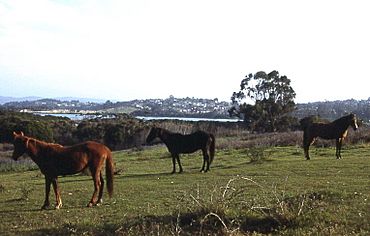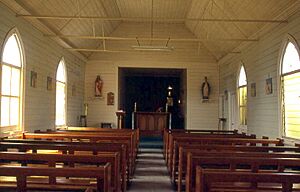Eden, New South Wales facts for kids
Quick facts for kids EdenNew South Wales |
|
|---|---|

Horses and the town in the background
|
|
| Population | 3,151 (2016 census) |
| Postcode(s) | 2551 |
| Elevation | 43 m (141 ft) |
| Location |
|
| LGA(s) | Bega Valley Shire |
| County | Auckland |
| State electorate(s) | Bega |
| Federal Division(s) | Eden-Monaro |
Eden is a cool coastal town in the South Coast region of New South Wales, Australia. It's about 478 kilometers (297 miles) south of Sydney. Eden is the most southern town in New South Wales. It sits on the beautiful Twofold Bay, which has one of the deepest natural harbors in the Southern Hemisphere! In 2016, about 3,151 people lived here.
The eastern coastline has rugged cliffs and a wide, sandy beach called Aslings Beach. This beach ends at the entrance to Lake Curalo, a safe place for boats. Even though people started settling in Eden in 1843, it wasn't officially called a town until March 20, 1885. Today, Eden's main jobs are fishing, forestry, and tourism.
Contents
History of Eden

First People and Early Explorers
Before Europeans arrived, the local Aboriginal people were the Thaua (or Thawa) people. They are part of the Yuin nation.
Whaling ships were already in the area by 1791. George Bass first found shelter in Twofold Bay in 1798. Later that year, he and Matthew Flinders explored the bay. They also met the local Thawa Aboriginal people for the first time.
In 1817, a botanist named Allan Cunningham landed at Snug Cove. He came to collect different plant samples from the area.
Whaling and Town Growth
The first whaling station was set up in 1828 by John Raine. Local Aboriginal people worked in the whaling industry. In 1834, the Imlay brothers started another whaling station at Snug Cove. They built a small hut there, which was the first known building in Eden.
Around 1860, whalers in Eden started working with orcas (killer whales). The Yuin Aboriginal people, who were part of the whaling crews, would not harm the orcas. So, a new plan was made: the orcas would help trap humpback whales in the bay. After the whalers caught the whales, the orcas were rewarded with parts of the whale carcasses.
People from the Monaro district, inland from Twofold Bay, needed a better way to send their cattle to Hobart, Tasmania. So, it was decided to build a town and cattle-handling area on Twofold Bay. In 1842, the area for the new town, named Eden, was surveyed. The main street, Imlay Street, was named after the Imlay brothers. Other streets were named after important people like Queen Victoria.
Eden was named after George Eden, 1st Earl of Auckland, who was a British Secretary for the Colonies. The first land blocks in Eden were sold on March 9, 1843.
Gold Rush and Development
Eden grew in the 1850s, especially after gold was found in Kiandra. This led to a gold rush in 1859–1860. For a few busy months, many gold seekers came to Eden. They bought supplies and then headed to Kiandra. When winter snows came, they quickly left. Eden was very busy for a short time, then returned to its usual quiet pace.
In the 1850s, Eden had four hotels. One of them, the Crown and Anchor, is still standing today. It was first licensed in 1845 and now offers accommodation. The first government school opened in 1857.
Shipping cattle from Eden stopped in the late 1890s. Before that, cattle were shipped to South Australia, Queensland, and even New Zealand.
Because Eden is about halfway between Sydney and both Melbourne and Tasmania, it was considered as a possible location for Australia's capital city after Australian Federation in 1901. However, Canberra was chosen instead. Whaling in Eden slowly stopped, ending completely in 1930.
Population Facts
According to the 2021 census, there were 3,350 people living in Eden.
- About 8.2% of the people were Aboriginal and Torres Strait Islander.
- Most people (79.0%) were born in Australia.
- About 87.7% of people spoke only English at home.
- The most common religions were No Religion (43.2%), Anglican (18.1%), and Catholic (17.6%).
Local Radio Station
2SEA FM is Eden's community radio station. It broadcasts along the Sapphire Coast of New South Wales. This station covers Eden, Pambula, Merimbula, and nearby areas. 2SEA FM is run by volunteers and gets money from sponsors to stay on air.
Industries in Eden
Eden has several important industries, mostly linked to tourism.
- Tourism: Many people visit Eden for its beautiful scenery and activities. There are lots of places to stay, eat, and have fun. Fishing and sailing are very popular. You can also take boat tours of Twofold Bay and go whale watching.
- Whale Watching: This is a big draw! Whales travel from Antarctica to warmer waters in June and July. They come back later in the year, and you can often see them from Eden. Tourism brings about AU$180 million to the Bega Valley Shire each year.
- Fishing: Eden has a large fishing fleet based at Snug Cove. A tuna cannery (a factory that cans tuna) opened in 1949 but closed in 1999.
- Forestry: Sawmilling, which is cutting timber into planks, has been an important local industry for a long time.
- History of Whaling: Whaling was very important to Eden's economy for over 100 years. The Eden Killer Whale Museum tells the story of whaling in the area. It also explains how orcas, led by a famous orca named Old Tom, helped whalers by herding whales into the harbor. The whalers would then reward the orcas.
Port of Eden
The Port of Eden is one of New South Wales' main regional ports. It's the biggest fishing port in New South Wales. The port also exports woodchips. The Department of Defence uses the port too, with a large wharf for their warships. Many cruise ships also visit Eden's port.
From the 1850s to the 1950s, the port was served by the Illawarra Steam Navigation Company. In 2021, the Royal Australian Navy ship HMAS Supply (A195) made Eden its ceremonial home port. The ship's crew even adopted Eden's killer whales as their official mascot!
Notable People from Eden
- Liz Cambage (born 1991), a basketball player
- Brett Kelly, a rugby league player
- Peter Kelly, a rugby league player
- Mary Braidwood Mowle, a diarist (someone who writes a diary)
- Corey Stewart, a rugby league player





